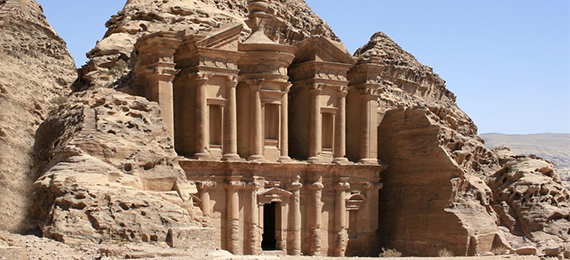
Petra, an ancient city in Jordan, which dates back to the Fourth Century BC, is located about 150 miles south of Amman and Jerusalem. It is considered to be magnificent by historians and archeologists because of its amazing architecture. It’s been referred to as the ‘Rose City’ because of the pink color sandstones used in the buildings.
History and Mystery of Petra
The Nabataeans, before they were conquered by the Roman Empire, controlled a massive space within the geographical region of Northern Arabia. Petra was designed by them keeping in mind that the sun would brighten their sacred places like celestial spotlights. The remains of their inventive water network, storage, transport, and irrigation systems are even found these days. Once Rome formally took over Petra, its importance in international trade began to fade. They annexed the newly gained territory and renamed it as Arabia Petraea. They continued to rule the town for over 250 years till the earthquake destroyed most of its buildings. Then came the Byzantines who took control over Perta and ruled it for approximately three hundred years.
Petra was mostly abandoned at the start of the Eighteenth Century. However it’s been noted for its distinctive design and innovative ideas by the Nabataeans that established the town. Nabataeans used an ancient way referred to as rock-cut design and carved many buildings within the town out of rock stones. Massive tombs that were designed by them eventually gave method for the Byzantines to make Churches.
Myths of Petra
In the movie Indiana Jones and the Last Crusade, Indiana Jones hunted for the Holy Grail in the city of Petra. One such myth about Petra originated from the Crusaders stating that it was somewhere in that area where Moses struck a rock to bring water to Israelites. Another myth is that there are remarkable treasures hidden in the building called the Treasury.
Innovative Water Technologies of Nabataeans
Living in Petra wasn’t a simple task for the Nabataeans because of its completely dried up land and arid climate. Since this was terribly difficult, they had to bring out ideas for adequate installation of water for the individuals and to maintain whatever they have planted. Some of their water channeling technologies are dams, cisterns, reservoirs and fresh water and floodwater harvesting. The Nabataeans designed stone walls and pillars to divide the water within the cisterns, to keep the water cool and prevent evaporation. They additionally created underground cisterns that were lined with waterproof cement to stop water from getting absorbed into the earth. These cisterns were created with secrecy in mind and this helped in protecting their installation from strangers and invaders.
10 Fascinating Petra Facts That Will Blow Your Mind
- The name Petra was derived from the Greek word called ‘petros’ which literally means rocks.
- Johann Ludwig Burckhard, a Swiss explorer discovered Petra in 1812.
- It’s also called The Lost City because it was unknown for about 5 centuries.
- Petra has around 800 carved tombs.
- The High Place of Sacrifice is a place where they do animal sacrifices and smoking the frankincense.
- Petra Theatre was formally constructed in Hellenistic style in 102 AD.
- The so-called Treasury Monument, in reality, is a tomb of an important Nabataean King.
- Along with India’s Taj Mahal, The Great Wall of China and Brazil’s Christ the Redeemer, Petra was named as one of the Seven Wonders of the World.
- Indiana Jones and The Mummy Returns are the most famous movies which were filmed at Petra.
- Petra was listed as a UNESCO World Heritage Site in the year 1985.